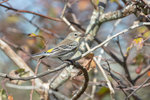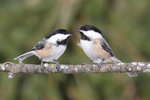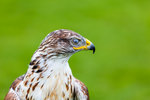


Last weekend we were walking the boardwalk at the Billy Frank Jr. Nisqually National Wildlife Refuge, and flying out from trees along a pond were several Yellow-rumped Warblers, each in their winter plumage but still showing a distinctive yellow rump patch. What impressed me was what they were doing: darting out from their perches to catch small flying insects. I didn’t see any insects – how did they manage the task?
So, back I went to do more research about the vision abilities of birds. You probably remember learning somewhere that our eyes have two types of light sensitivity receptors, rods and cones. Rods are very light sensitive and better for seeing in dim light; they detect the various of gray, but not color. Cones are able to detect different colors or wavelengths of light. Humans have many more rods than cones (about a twelve-to-one ratio).
Birds, even those with small eyes, have many more sensory receptors than humans – up to three times more. That’s like having three times more pixels in a camera image – more receptors equal sharper vision. Those warblers can just see much better than I can.
Also, the ratio of rods and cones in most birds’ eyes ratio is the reverse of the human ratio – they have many more cones than rods. You may think you can see an amazing variety of colors, but we humans have poor color perception compared to birds. And, more amazing, most birds can see color on the ultraviolet (UV) end of the color spectrum that is invisible to us.
With this column is a photograph of a pair of Black-capped Chickadees. They are identical in size and apparent coloration and though they look identical to us, they can tell the difference. Male chickadees have cheek feather patches that reflect UV light. Thus, for chickadees, males are obvious due to their cheek patch color and the brilliance of that invisible-to-us color patch may play an important role in courtship success for males.
In fact, studies suggest that many, if not most, bird species that we see as sexually monochromatic (that is, being the same color) actually have sexually distinct color patterns, but they’re on the UV end of the color spectrum. Also, for birds where we see colorful distinctions, those colors may be much more brilliant than our eyes allow us to imagine.
That made me wonder whether those insects the warblers were so easily catching glow for them in some UV coloration. And, with a little research, I found out that many flying insects indeed have body coatings that reflect UV light.
There is another interesting eye characteristic that birds have – a third eyelid that passes back and forth across the eye. This is called a nictitating membrane. All birds have this, but it’s more important for raptors, our birds of prey. Here’s an experiment you can do yourself. Drive slowly along in the car, roll down the window and stick your head out while keeping your eyes open. Unless you are wearing goggles, your eyes instantly start to water, clouding your vision, and hopefully you will not encounter dust or a tiny flying insect.
Now imagine instead you are a hawk soaring above looking for dinner, spotting something, and then diving down to catch it. You’ve got to keep those eyes open to be successful, but you cannot risk injury - a raptor with an injured eye likely will be a dead raptor. That nictitating membrane, shown in the accompanying photograph of a Ferruginous Hawk, solves the problem – it protects the eye while allowing vision. They accomplish their hunt in large part because they wear this pair of natural goggles.
To bring our discussion full circle, a researcher in Finland awhile back was wondering how raptors manage to find small prey living in grass. Meadow voles (a type of small rodent) were a big part of the raptors’ diet, but they were always well hidden. The researcher discovered that as voles wander, they mark their trails with urine. And, ironically for the vole I guess, their urine reflects UV light. The urine trail, visible to the sharp-eyed raptor, leads it right to its prey.
George Walter is environmental program manager at the Nisqually Indian Tribe’s natural resources department; he also has a 40+ year interest in bird watching. He may be reached at george@theJOLTnews.com
Photos for this column, unless otherwise noted, are provided by Liam Hutcheson, a 15-year-old Olympia area birder and avid photographer.
Comments
No comments on this item Please log in to comment by clicking here